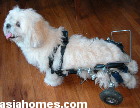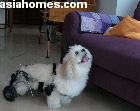|
Toa Payoh
Vets Clinical Research
Making veterinary surgery alive
to a veterinary student studying in Australia
using real case studies and pictures |
|
PARALYSED AND BLOOD IN THE
URINE IN A DACHSHUND
Dr Sing Kong Yuen,
BVMS (Glasgow), MRCVS
First recorded: 27 April, 2003
Updated:
23 February, 2010 |
| |
 toapayohvets.com toapayohvets.com
Be Kind To Pets
Veterinary Education
Project 2010-0129 |
The Lhasa Apso had intervertebral disc
disease (IVDD)
 "The
vet operated on the paralysed dog's spine
and the fees cost the owner over $5,000!"
the pet shop owner said. "The dog was still
paralysed." I was vaccinating his puppies at
his pet shop in a small suburban mall. Two
vaccinations are mandated by the Agri Food
and Veterinary Authority prior to sale and I
visited him in this severe acute respiratory
syndrome (SARS) climate to let him know that
dogs don't get SARS. SARS dominate the
news every day as there is no prevention by
vaccination against the SARS coronavirus. "The
vet operated on the paralysed dog's spine
and the fees cost the owner over $5,000!"
the pet shop owner said. "The dog was still
paralysed." I was vaccinating his puppies at
his pet shop in a small suburban mall. Two
vaccinations are mandated by the Agri Food
and Veterinary Authority prior to sale and I
visited him in this severe acute respiratory
syndrome (SARS) climate to let him know that
dogs don't get SARS. SARS dominate the
news every day as there is no prevention by
vaccination against the SARS coronavirus.
The pet shop owner judged a veterinarian's
competence on success. Results of success in
treatment are what his clients want when he
recommend a veterinarian to them.
In the pet shop owner's point of view, the
knowledge, skills and training of the vet
who performed the spinal disc surgery were
suspect when the dog was not able to walk
after the surgery.
The chances of success depends on the extent
of injury, how soon the surgery is performed
and the competence of the veterinarian.
In the U.S, most cases are performed by the
University veterinary teaching department
where there is specialisation, money and
equipment to do neuro-surgery. As more cases
are handled, competence is gained.
Singapore does not have specialists in
canine neuro-surgery.
A website,
http://www.dodgerslist.com details
various experiences of dog owners with
Dachshunds suffering from intervertebral
disc diseases. There are success stories of
surgeries and successes without surgery.
Surgeries cost a lot of money and many
owners just can't afford the fees. One write
claimed that Australian veterinarians in
Australia seldom perform surgery and 90% of
the cases recover with strict cage rest for
six weeks, lots of tender loving care and
medication!
Many Singapore owners of paralysed dogs in
Singapore usually do not know what to do
when their dogs are paralysed in the hind
limbs. This educational article may help
them decide on the best course.
Dachshunds with their long bodies get
chrondodystropy (brittle spinal discs).
Old Pekineses may suffer from calcified
spinal discs. Jumping up and down sofa
sets and running up and down few flights of
steps daily for apartment dogs cause damage
to the spinal disc. The first sign will be
that of the dog unwilling to climb up or
down stairs at around age 5 years.
Sometimes, the owner present the dog with a
complaint of "not eating much." In one case,
the fifty-year-old owner came to me for a
second opinion after complaining that the
vet who could not speak his Hokkien dialect
and had to use the nurse as an interpreter
had diagnosed kidney and liver disease, the
need to do blood tests, X-rays and the
possibility of an operation. What the
vet meant was that there was a need for more
detailed test and these would mean extra
expenses.
"How come the dog is still not walking?" he
phoned me three days after the Prednisolone
injection. He could not understand that the
dog needed crate rest (confined to a cage
except for passing stools and urine) for at
least 2 months and re-examination.
Intervertebral disc disease is easily
diagnosed based on symptoms and examination.
X-rays of the spinal disc were out of
question as it would add to the cost and
most owners want the least cost treatment,
meaning less than fifty dollars. After
all, a general practitioner in human
medicine charges around twenty to thirty
dollars for a cough and cold case.
Sometimes, a house call may be needed for
paralysed dogs. One day, a housing
agent phoned me to make a house call to an
American lady whose paralysed dog passed
blood in the urine.
"How much will you charge?" he asked. House
calls are time consuming and the charges of
$50 may be affordable.
"I charge $50 if the lady permits me to take
some pictures of her dog in a wheel chair
for educational purposes to benefit dog
owners on the web. There is a shortage
of such educational material in Singapore."
"It's a deal," Gary called back. He was a
close friend of the lady. Hence the pictures
below for Singapore dog owners.
This Lhasa Apso, much loved by the lady, was
operated in the U.S at around $3,000 (I
presume it is US$3,000) four years ago and
had never recovered her ability to walk.
This would be a case of "After spending so
much money, the dog is still paralysed" but
she did not blame the veterinarian as she
 was
educated and well informed. was
educated and well informed.
She got her dog wheel chairs from
www.k9carts.com. However, the management
of the paralysed dog is very important. The
owner is aware of the problems of urinary
stasis and expressed the urine out of the
bladder daily direct into the toilet bowl.
She held the dog firmly and massaged the
bladder. Urine flowed into the toilet bowl.
I was impressed as I had not thought of this
method to advise other owners. "People may
laugh at me," she said.
I had asked her to collect the urine so that
I could see what was passed out.
 There
was a large piece of bladder mucosa of
around 1 cm x 1 cm in size in the dark
coloured urine kept in the bottle. Why was
the mucosa detaching from the bladder was a
mystery to me. Could it be her frequent
expression of the bladder? I advised that
the dog drink more water. I forgot to ask
her how she managed the lack of control of
passing stools. There
was a large piece of bladder mucosa of
around 1 cm x 1 cm in size in the dark
coloured urine kept in the bottle. Why was
the mucosa detaching from the bladder was a
mystery to me. Could it be her frequent
expression of the bladder? I advised that
the dog drink more water. I forgot to ask
her how she managed the lack of control of
passing stools.
Antibiotics were given. The dog was given a
dextrose saline injection as that was what
her vet used to do.
"Why can't the manufacturer produce a flat
board so that the hind legs and body rest on
the board instead of going through two
rings?" the lady asked.
This sounds logical as it is quite
troublesome to have to put the legs into the
rings.
"Most likely, the dog will develop pressure
skin sores," I said. "Friction between the
lower part of the body with the board will
be there when the dog moves." The
contraption produced by
www.k9carts.com fitted this Lhasa Apso
who could move freely. On further
thoughts, the bladder would be leaking urine
continually as the dog moved due to friction
from the board and the urine would cause
skin sores.
The Lhasa Apso dragged herself on the marble
floor most of the time. "This will lead to
some skin sores on the lower part of the
body," I said to the owner.
"Some parts of the abdomen nearer to the
bladder area have become hyperpigmented
(more melanin pigments deposit on the skin
due to friction with the floor or the dog
licking the area).
This Lhasa Apso looked very young but she
was around 8 years old. It was good to know
that the lady owner cared so
 much
for the Lhasa Apso which would have been
euthanased or have died of urinary bladder
infection long ago since many owners don't
know how to manually express the urine from
the bladder. much
for the Lhasa Apso which would have been
euthanased or have died of urinary bladder
infection long ago since many owners don't
know how to manually express the urine from
the bladder.
Preventing the soiling of the body due to
the lack of control of the bladder and
bowels is very important in the care of a
paralysed dog as the skin becomes inflamed
and infected if there is no regular
cleaning. Prevention by not giving
snacks to the dog leading to weight gain,
not permitting the long-bodied dogs to jump
up and down furniture and run down stairs
over the years are easily said than done.
In mild first-time cases where the vet can
detect pain proprioceptive reflex when
pinching the skin of the toes and the dog
can feel its paws when they are placed on
the table edge, corticosteroids and enforced
crate rest (no jumping or running around)
for 4-8 weeks, exercise restriction, massage
and physical therapy such as whirlpool bath
(hydrotherapy) may be all that is needed to
recovery. If no pain reflex is
detected, the dog has severe IVDD and
surgery may be needed although there is no
guarantee of success.
References:
Virginia Maryland Vet
Teaching Hospital - Intervertebral disc
disease
 Sam
had
IVDD (intervertebral
disk disease)
and recently had surgery at the Virginia
Maryland Vet Teaching Hospital. He is
recovering well and is going home in a
dog-on-wheels cart for help with mobility
until he has full use of his back legs
again. Sam
had
IVDD (intervertebral
disk disease)
and recently had surgery at the Virginia
Maryland Vet Teaching Hospital. He is
recovering well and is going home in a
dog-on-wheels cart for help with mobility
until he has full use of his back legs
again.
Blood in the dog's urine and urinary tract
infections:
Possible causes are:
1. Urinary tract infections (Fever is
usually present).
2. Urinary crystals or stones (Stones scrape
urethra).
3. Trauma (Injury - internal organs
including bladder).
4. Tumours. Old dog. Bladder, Kidney,
Prostrate, Others
5. Toxicity. Swallow rat poison.
6. Tick bite babesiosis.
7. Prostrate infection. (Palpation of
enlarged prostrate).
Consult your vet promptly as delays may lead
to the death of your dog.
More interesting Singapore canine cases from
the past years at Toa Payoh Vets are at:
Dogs
|
|
|
 toapayohvets.com toapayohvets.com
Be Kind To Pets
Veterinary Education
Project 2010-0129 |
|
|
 Toa
Payoh Vets Toa
Payoh Vets
Clinical Research
|
|
|
Copyright ©
Asiahomes Internet
All rights reserved. Revised: February 23, 2010
Toa Payoh Vets
|
|
 TOA
PAYOH VETS
TOA
PAYOH VETS TOA
PAYOH VETS
TOA
PAYOH VETS